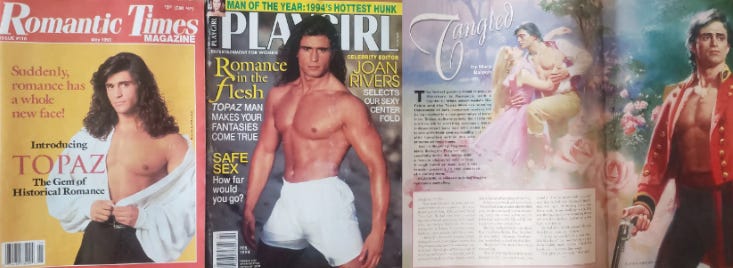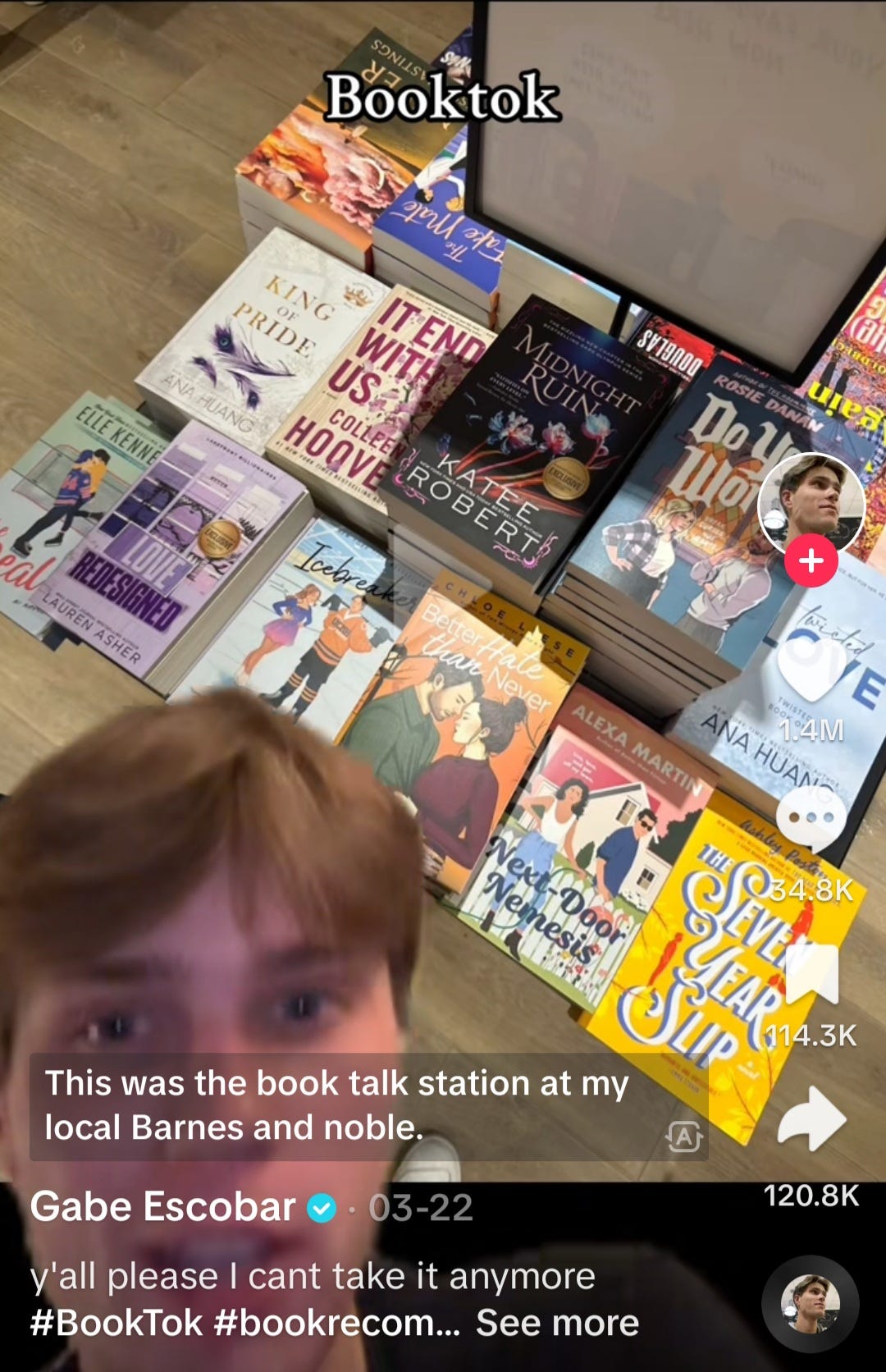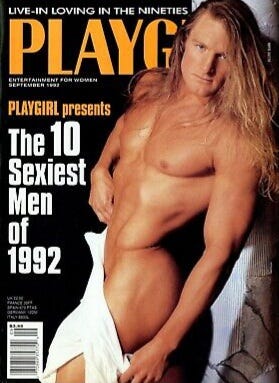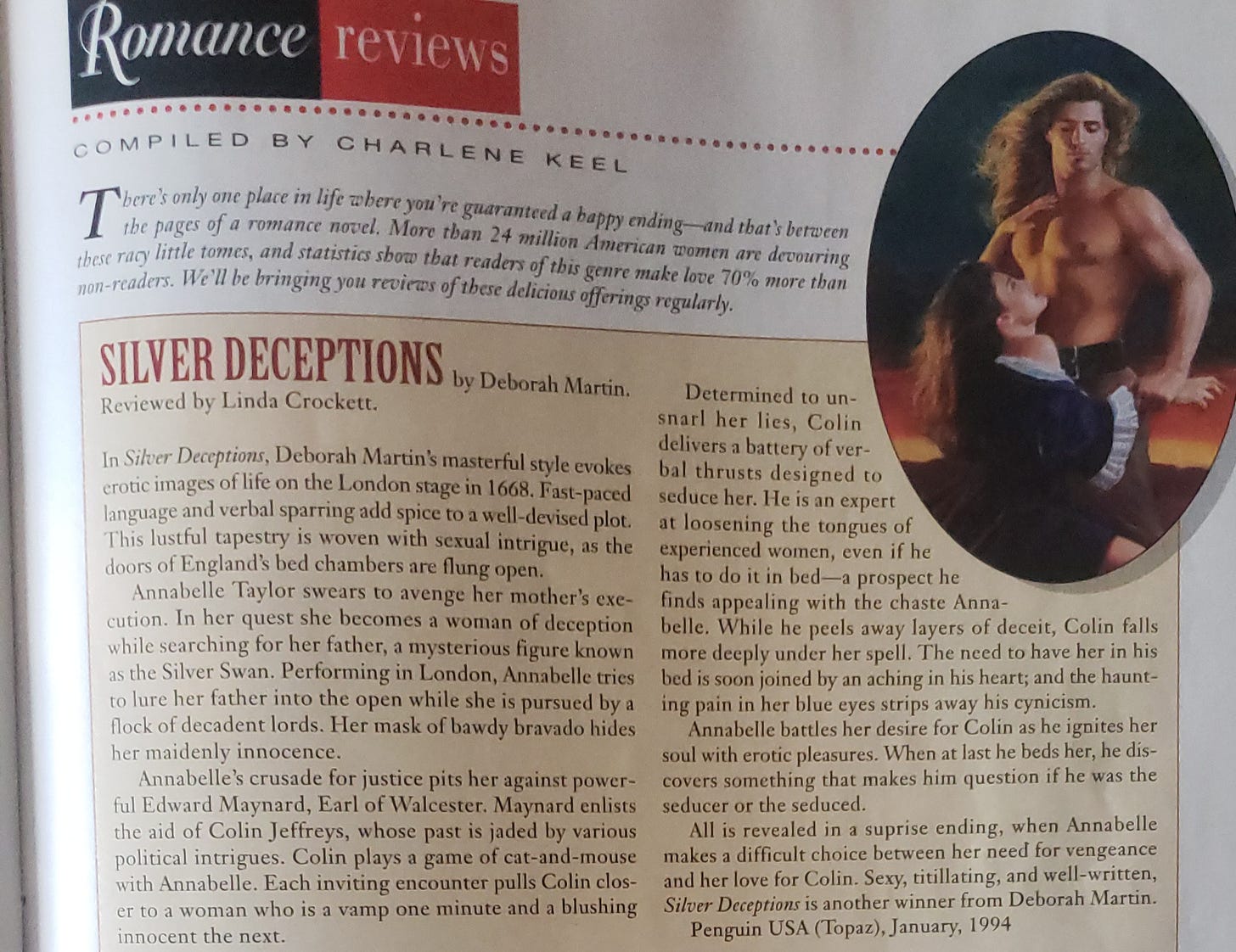“Does anybody on this godforsaken app read a single book that isn’t straight up POR-” an influencer bemoaned to his three million followers on TikTok last month.
TikTok has a strict-yet-inscrutable censorship policy, so if you say “porn” in all it’s wanton glory there’s a good chance you’ll get your video taken down. This guy’s workaround, sputter-screaming the word and dropping the last letter, had the hilarious result of making him sound like he exhumed the hateful spirit of Phyllis Schlafly.
There are a few big philosophical questions that humankind never seems to stop grappling with: Is there a God, and is my God the true God? Should we take the deontological or utilitarian approach to ethics? and finally, Are romance novels porn?
Luckily for us, the greatest minds of the next generation are on the case.
The debate is boring, circular, and only seems to benefit the conservatives who regularly cash in on accusations of sexual deviance to legislate around what is, essentially, a moral panic. What’s interesting is that I watched this backlash happen in real time. In August 2022, most of the headlines about BookTok’s romance readers were fawning: “Gen Z is driving sales of romance books to the top of best-seller lists.” In March 2024, a decidedly different tune: “Children exposed to ‘spicy’ adult fiction by BookTok influencers.”
The first article touts Gen Z’s interest in romance (specifically from BookTok) as a sign that romance novels, and women’s sexuality, are no longer stigmatized. The second one basically calls those same creators sex pests. Life comes at you fast.
But is this truly a Gen Z thing, or have we been here before?
Roll tape!
The Bartling Brothers
In the early 90s, Jim, Kurt, and Kris Bartling were hog farmers in Unadilla, Nebraska with the shared dream of breaking out into the entertainment world. The blond, bodybuilding trio were corn-fed locals, dividing their time between manual labor and dancing at at male revues before they got their big break in 1992 when Jim’s wife, Angela, entered his photograph into Maury Povich’s “Hunk Hunt.” The grand prize, a centerfold spread in Playgirl Magazine, propelled Jim into the national spotlight.
Jim Bartling’s origin story was deliciously rural, the stuff that profile writers dreamed of. With his long blond hair and muscled physique, he was a farm-to-boudoir Fabio. Jim told the Omaha World-Herald that he hoped to use his Playgirl fame to launch a multi-faceted career in “modeling, music videos, exercise tapes, posters and ultimately, roles in action-adventure movies like Van Damme’s Universal Soldier.” This is a path most successfully tread by the Italian-born model-turned-pop-culture-icon Fabio, who wrote romance novels (with ghostwriter Eugenia Riley), recorded a baffling spoken-word album, and hawked margarine in a now-legendary ad campaign.
Fabio’s modeling career took off with his mid-80s GAP ads, but his name is inextricable from romance thanks to his work on Johanna Lindsey’s historical romance novels, painted by veteran cover artist Elaine Duillo. Bartling, who was already drawing Fabio comparisons in 1992, leaned into the similarities by booking modeling gigs on romance covers called a “clinch,” a horny cover style with a disheveled and windswept couple embracing, frequently associated with swashbuckling historical romances.
But Jim Bartling also had something Fabio didn’t, something that no series-minded romance reader could resist. Brothers who were also models.

The media, of course, went to town on this discovery. The headlines after their mid-90s Bookfest appearance were particularly inspired: “Women go hog wild over model farmers” declared The Palm Beach Post. “Bartling brothers hog spotlight” crooned South Florida Sun Sentinel. (“I will boar witness to pig puns” squealed The Loose Cravat.)
Along with successful cover models Fabio, John DeSalvo, and Steve Sandalis, the Bartling Brothers were backed by a promotional force: The Romantic Times.
Mr. Romance
Kathryn Falk founded the Romantic Times, the genre’s most popular and longest running magazine, in 1981. To fans it was a lifeline: the burgeoning genre was skyrocketing in popularity and ignored (or sometimes ridiculed) by major publications, and the Romantic Times was a much-needed hub for genre news. It was a hotbed of industry gossip, reviews with inscrutable ratings (I’m confused, yet compelled, by the “heart system”), and publishing advice for aspiring authors. Not everyone felt so positively. “It’s first and foremost a fanzine,” an anonymous publisher told Paul Grescoe in The Merchants of Venus: Inside Harlequin and the Empire of Romance. “It’s an ego trip for the writers. It should be a trade journal. So there’s a real void in this industry. I’d appreciate it if you didn’t quote me on that.”
Falk herself was one of the genre’s great eccentrics, a showwoman at heart whose success was bolstered by leaning heavily into romance’s campier elements. She plotted (unsuccessfully) to release doves over a Romantic Times Booklovers’ Convention in 1983, raffled off a prized lunch with a titled man (Hussar uniform required), and confidently referred to her copy editors as “virgins.” In George Csicery’s documentary Where the Heart Roams, she conducted her interview in an Amtrak train car swathed in silk sheets and pillows she brought for the journey.
Grescoe’s Merchants of Venus is first and foremost a book about the Canadian publishing giant, Harlequin, but Grescoe couldn’t resist using Falk, and the Romantic Times Booklovers Convention, for his dramatic opening act. Falk, who claimed to have helped propel Fabio to international spotlight, had recently upped the ante at her conventions with the Mr. Romance Cover Model Pageant, a live show where hopeful hunks competed to launch their own romance modeling career. Grescoe called the pageant a “tangible acting out, a visual parody” of a literary genre with wide-appeal constantly battling “lowbrow” accusations. Oh, you think romance novels are salacious and witless, nothing but fantasy fodder?
No one cares. Now let’s evaluate some muscle hunks.
Smut Wars
In The Merchants of Venus, Grescoe noted the lack of Harlequin executives at the Romantic Times convention he visited, implying that the publishing company was too big to sweat Falk’s wrath. Her mercurial reputation preceeded her: a New York Times profile revealed that both Walter Zacharius, founder and CEO of Kensington, and Ellen Edwards, Avon’s romance editor, believed that writers and editors feared her displeasure. “Falk is loyal to many writers, but not all,” wrote Grescoe. “she called Kathleen Woodiwiss, author of the trendsetting The Flame and the Flower, Woodishit.”
The Romance Writers of America, the once-mighty trade organization that was also founded in 1981, had a surprising overlap with the Romantic Times, which was at the time being labeled a tabloid. In the early 1980s the publishing industry could barely keep up with the demand for new romance novels, so converting romance readers to writers subsequently became its own industry. (“Rome wasn’t built in one day,” wrote the New York Daily News in 1981. “But three romance books were.”) Falk had her finger on the pulse: the Romantic Times hosted workshops and distributed publishing advice, and Falk herself compiled multiple books on the subject, including How to Write a Romance and Get it Published.
Meanwhile, the Romance Writers of America were having their own internal upheavals, as the RWA’s controversial decision to open their doors to aspiring authors — a move that was practical and admirable in theory — made it become “as much social club as a professional organization,” according to Texas Monthly. If the Romantic Times were helping aspiring authors and holding conventions, and the Romance Writers of America were doing the same (sans Brigadoon-themed muscle pageants), a clear line in the sand had to be drawn.
As Grescoe cheekily pointed out, by the mid-90s, only 20% of RWA’s membership were published authors. That select group, the Published Authors Network, raked Falk over the coals for her antics in their newsletter, PANdora’s Box, claiming that the Romantic Times founder made a joke out of the romance industry with her oiled-up muscle men pageants. The screed went unsigned, as PAN feared retaliation. “I think every single member of PAN understands exactly what would happen to any author who dared to sign her name to a letter of commentary such as the one we’re discussing,” The Merchants of Venus quoted the newsletter’s lament. “To suggest otherwise is to ignore reality.”
While factions of the RWA were getting the vapors over Falk and the Romantic Times, another, more salacious magazine entered the romance ring: Playgirl.
Playgirl was not simply Playboy for women. It would be more accurate to say it was full-frontal Cosmopolitan. Founded in 1973 by nightclub owner Doug Lambert, the magazine courted a socially conscious, feminist audience. Jim Bartling, a 90s Romantic Times convention staple, got his start in Playgirl, and the magazine continued to draw from the same pool of models. When Penguin launched Topaz Books, and subsequently their brand-loyal brunette Fabio knock-off, “The Topaz Man” AKA Steve Sandalis, he graced the cover of Romantic Times in 1993 to announce the launch. Less than a year later, Sandalis was on the cover of the more widely-distributed Playgirl, along with a multi-page illustrated excerpt from Mary Balogh’s Regency romance Tangled.

According to The Sydney Morning Herald, an irate Kathryn Falk pejoratively referred to Playgirl as a “nudey” magazine for gay men. This was an accusation that plagued the magazine for its entire run. In a 1983 interview with the Santa Cruz Sun Sentinel, Playgirl centerfold Joe Ingrim felt compelled to instruct the paper, “Say this in your article: I am not gay. I have nothing against gay people, but I am not gay.”
Even Playgirl’s Wikipedia page says it “quickly developed a significant gay male readership” in the opening paragraph, but while there were gay men who read the magazine and posed for cover shoots, the percentage of gay men who subscribed has been consistently overstated thanks to the usual suspects: homophobia and sexism. In an interview with Knight-Ridder in 1981, Playgirl’s then Executive Editor, Dianne Grosskopf, pointed out that Playboy’s readership was 20% women, while Playgirl’s male readership capped out at 17%. “It’s the old double standard,” Grosskopf said. “No one would ever ask if Playboy was aimed at a lesbian audience.”
The two magazines’ rivalry came to a head at the 1994 Romantic Times Booklovers convention at Nashville’s Crown Plaza, when Playgirl’s Managing Editor, Charlene Keel, showed up to cover the event. Falk, feeling threatened by Playgirl’s recent move into reviewing romance novels, told Keel to leave, and Keel shot back that she was there in a reporting capacity. “Keel claims that Falk stole her tape recorder, and “pushed and pulled” her through the automatic doors until she fell to the ground, resulting in bruising and a suspected concussion,” wrote Fiona Giles for The Sydney Morning Herald. The altercation ended dramatically, with Keel leaving the Crown Plaza in an ambulance. Wary of a possible impending lawsuit but seemingly unrepentant, Falk told Giles: “You can say this. Some women are putting together a t-shirt for me that says Kathryn Kicks Ass in Nashville.” She then added, “And say this too! Romance wins over smut!”
She gave a more subdued statement to the Associated Press: “Philosophical differences exist between our impressions of the meaning of romance.”
The New York Times praised Falk in 1996 for her exhibitionism, and for being bold in the face of mockery from both romance insiders and the general public. “But the snickering is back,” they wrote. “The clinch covers are considered embarrassing. Writers and editors want to give the books some classiness. Some publishers are substituting flowers and swans for clinches, to attract readers who would otherwise never allow themselves to be seen with such books.”
The Times also reported that Charlene Keel, who never filed a lawsuit, had no hard feelings about the Nashville altercation. “I am willing to extend the olive branch,” she said. “[Falk is] temperamental but brilliant.”
I have never seen a better distillation of romance’s relationship with pornography than I have with the Romantic Times and Playgirl brawl. Yes, romance is not synonymous with pornography, but what comes of splitting hairs? The published writers of the RWA, trying to get ahead of lowbrow accusations, anonymously scoffed at Falk’s salaciousness. In turn, Falk, who thumbed her nose at respectability and regularly waxed poetic about women’s fantasies, felt the need to draw a line in the sand about Playgirl’s full-frontal nudity.
But that arbitrary line didn’t make the clinch covers her model protégés posed for less “embarrassing” to the general public in the 90s, and the BookTok table at Barnes & Noble, entirely bereft of muscle hunks in 2024, is still too raunchy to beat the porn accusations.
Think of the children
After Jim Bartling got his big break in 1992, a woman wrote in to the Nebraska paper to chastise them for championing a man who posed nude for a magazine “in an age when concerned citizens groups are working to remove this type of ‘soft porn’ from the shelves of our bookstores.”
This is surprisingly similar to the words uttered by the TikTok influencer, who, after expressing concern about BookTok’s porn addiction, clutched his proverbial pearls about the possibility of children picking up a smutty novel from Barnes and Noble. This is a disingenuous concern. Why do people only think of the children in scenarios that call for censorship? What about more pressing concerns like housing, healthcare, and education? I scrolled through this influencer’s page, and most of his videos were about pop culture or musical theater — child welfare never came up again.
Recently Rolling Stone published “Why Women Online Can’t Stop Reading Fairy Porn,” investigating the success of Sarah J. Maas’ fantasy romance A Court of Thorns and Roses (referred to simply as ACOTAR by fans). The article, which straddled the line between being tongue-in-cheek and dismissive, repeatedly called ACOTAR “fairy porn” without explaining that this is a BookTok in-joke. You could head to any bookstore’s romance section, close your eyes, and randomly pick out a book that’s more sexually explicit than ACOTAR. The “fairy porn” joke is both self-deprecating and a fuck you, the 2024 equivalent of Falk responding to “mommy porn” allegations by lining up shirtless men on a stage.
But the game is different now, and the stakes are higher. The 90s variety of pearl clutching took the form of a sternly worded, anonymous letter. With social media, the floodgates have opened up into something much, much scarier. When a mutual of mine pointed out on TikTok that “BookTok is full of porn addicts” is a misogynistic statement, she received thousands of comments calling her a “gooner” (a stupid way of saying “porn addict”), a rape apologist, and a pedophile. This level of mass harassment over a benign statement is as terrifying to me as it is eye-opening: these people do not care about hypothetical children — they just want to watch you suffer.
If this sounds familiar, it’s because it’s a play conservatives use to legislate queer people out of existence: call us perverts, say think of the children, and see if they can make us disappear.
In 1999 the Bartling Brothers retired from the spotlight and went back to their Unadilla farm, or as the Lincoln Star Journal elegantly put it: “Pumped-up pork producers turn their muscular backs on fame.”
This line has been rolling around in my head for weeks; I’m convinced it presaged our 21st century puritanical decline. We’ve regressed! We’ve regressed! Bring back the muscle hunks!
Source Timeline:
Oct. 11, 1981: “Where Love Has Gone (To Brooklyn, Where Else?) — Carol Wallace, New York Daily News
Oct. 21, 1981: “Phone calls are starting for Playgirl’s playboy from Soquel” — Marybeth Varcados, Santa Cruz Sentinel
Nov. 5, 1981: “These Pinups are for Playgirl Only” — Marsha Kay Seff, Knight-Ridder
Dec. 6, 1981: “Playgirl’s Man: Sensitive and Nude” — Marsha Kay Seff, Knight-Ridder
Aug. 6, 1992: “More than a hunk” — Pat Dinslage, The Grand Island Independent
May 17, 1994: “Romance — and fury” AP Staff, Associated Press
Jul. 9, 1994: “Battle of the Bodice Rippers” — Fiona Giles, Sydney Morning Herald
Feb. 19, 1995: “Bartling brothers hog spotlight” — Phil Davis, South Florida Sun Sentinel
Mar. 27, 1995: “Convention caters to passions of romance novel fans” — Staff, The New York Times
1996: The Merchants of Venus: Inside Harlequin and the Empire of Romance by Paul Grescoe
Dec. 10, 1996: “A Magazine for Romance Novels And the Women Who Love Them” — Barbara Stewart, The New York Times
Aug. 29, 1999: “Pumped-up pork producers turn their muscular backs on fame” — Peter Salter, Lincoln Journal Star
Sep. 2020: “Vivian Stephens Helped Turn Romance into a Billion Dollar Industry. Then She Got Pushed Out” — Mimi Swartz, Texas Monthly
Apr. 6, 2024: “Why Women Online Can’t Stop Reading Fairy Porn” — CT Jones, Rolling Stone
Me, Elseware:
I’ve been slower to write on this Substack because I’m in the midst of recording a two-part episode about Janet Dailey for the Reformed Rakes podcast. Janet Dailey, if you’re unfamiliar, was once the most famous romance novelist in the world before she tanked her reputation by plagiarizing from Nora Roberts. I’m very surprised by what I’ve uncovered about her life pre-scandal. Part one is a story of fame, violence, lawsuits, and country music, and it will hopefully be out late next month.
In the meantime, we’ve had some amazing episodes on Reformed Rakes! Emma recently led an episode on the Bow Street Runners, and we had our good friend Mel (@pagemelt on TikTok) on to talk about Think of England by KJ Charles.










‘Romance wins over smut!’ ‘Rectangles win over squares!’ Thank you for writing this, it’s weirdly comforting to be reminded that respectability politics have been doing the same boring shit for decades.
Great article! When that video went viral I was hoping you would write something cause I love your responses